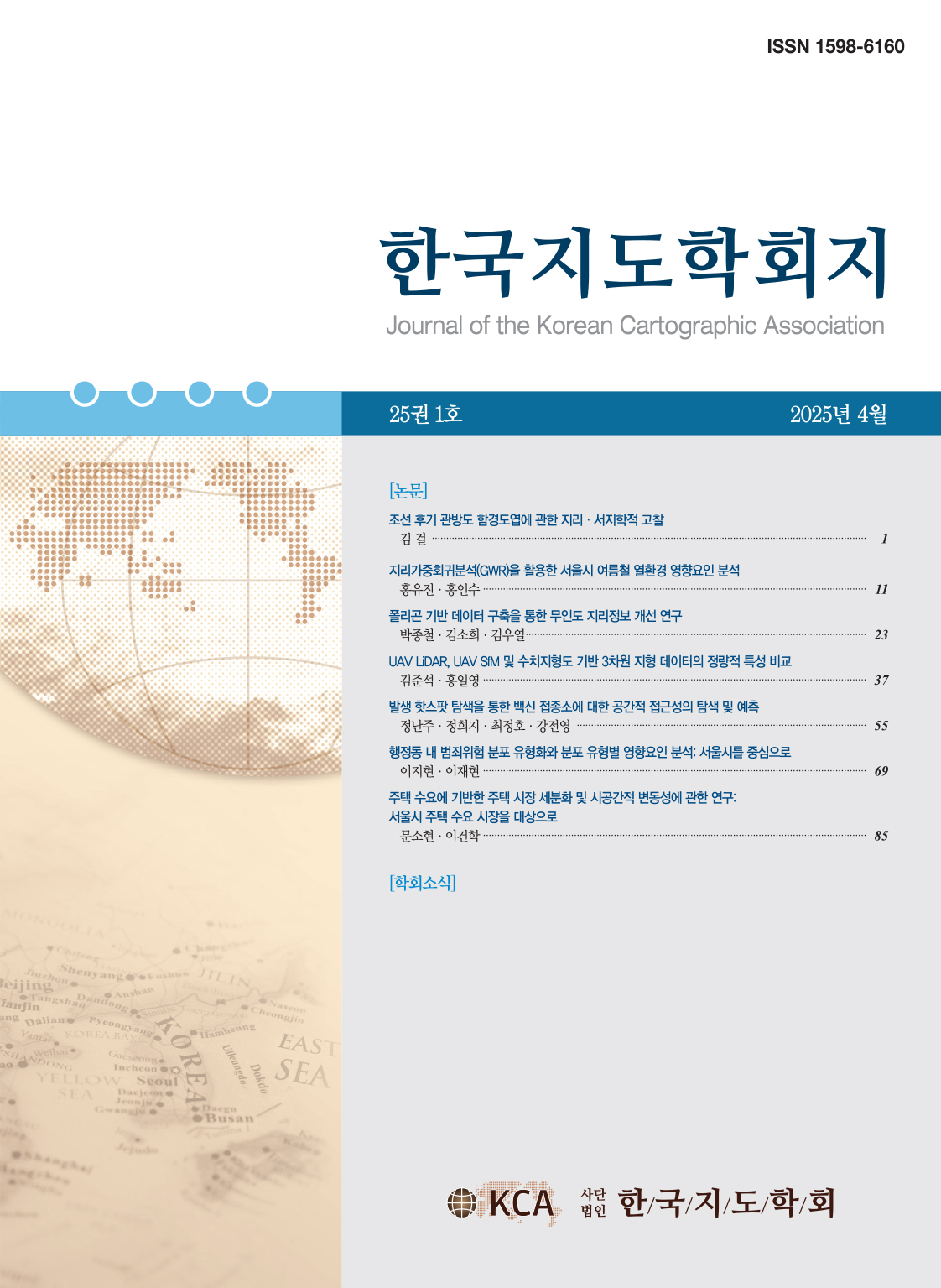Research Article
Abstract
References
Information
This article examines neighborhood effects from a perspective on the geography of education, in the context of growing attentiveness paid to spatial approaches to educational issues. In particular, spatially differentiated academic achievements are analyzed in the study. To that end, a multi-level modeling involving individual, school, and neighborhood levels is employed. As a result, two major findings are found. First, it is found in an analysis on neighborhood effects that the individual level has the highest influence on students’ academic performance, which is followed by school and neighborhood levels in order. Meanwhile, different neighborhood effects are observed among different school subjects, such that in College Scholastic Ability Test (CSAT) Korean Section and English Section have 3.6% and 5.6% ICC – which quantifies neighborhood effects – respectively. Second, the degree of neighborhood effects tend to decrease in most regions as analysis moves from model 0 to 3, but some regions still have higher neighborhood effects than others. These findings have significant education policy implications because they help understand spatial inequality in education with quantifiable evidence.
본 연구에서는 기존의 네이버후드 효과 연구가 가지는 방법론적 이슈를 고려한 실증적인 방법을 적용하여, 학생들의 학업성취도에 대한 네이버후드 효과를 규명하고자 하였다. 연구 목적의 달성을 위하여 개인-학교-네이버후드 3수준의 다수준 모형 분석을 수행하였다. 분석의 결과는 다음과 같다. 첫째, 기초모형을 통해 학생들의 수능 점수에 대한 수준별 영향력을 확인한 결과, 개인, 학교, 네이버후드 순으로 높은 영향을 미치는 것으로 나타났다. 네이버후드 효과의 정도는 과목별로 다소간의 차이가 있었는데, 국어에 비해 영어 점수에 대한 네이버후드 효과가 더 높게 나타났다. 둘째, 모형 3을 통해 지역별 네이버후드 효과를 살펴본 결과, 대부분의 지역에서 이전 모형에 비해 네이버후드 효과의 정도가 감소하였다. 그러나 양천구, 강남구 등 일부 학교군에서는 여전히 높은 네이버후드 효과가 존재하는 것으로 나타났다. 본 연구는 그동안 논쟁이 되어왔던 네이버후드 효과에 대해 실증적인 분석을 통해 정량적인 수치를 제시하였다는 데에 의의가 있다. 이러한 결과는 학업성취도의 공간적 격차와 관련하여 교육정책의 방향을 결정하는 데에도 도움이 될 것으로 기대된다.
- 강상진, 2016, 「다층모형」, 서울: 학지사.
- 강우진, 2018, “인구구조변화와 세대 간 재정지출 배분,” 한국정책연구, 18(3), 93-109.
- 교육부, 2015, 「2015 중・고등학교 학교생활기록부 기재요령」, 교육부.
- 김감영・용환성, 2014, “도시 내 학업성취도 격차와 학령인구 이동과의 관련성 : 대구광역시를 사례로,” 한국지도학회지, 14(2), 53-72. 10.16879/jkca.2014.14.2.053
- 김민희, 2014, “특별교부금제도 관리 운영과정 개선방안,” 敎育財政 經濟硏究, 23(2), 59-91.
- 김보경・최지은・유평수, 2015, “대입전형이 고등학교 교육과정 정상화에 미치는 영향,” 교육종합연구, 13(1), 93-119.
- 김소연・김영호, 2013, “주거지 인문환경의 공간 속성을 고려한 주택 가격 결정 모형,” 한국지도학회지, 13(3), 41-56.
- 김영길, 2016, “목적사업비가 학교재정 배분의 공평성과 효율성에 미친 영향,” 전북대학교 박사학위논문.
- 김지우・이건학, 2019, “지리가중회귀 모델을 이용한 학교급별 학업성취도 영향 요인 분석,” 대한지리학회지, 54(5), 561-576.
- 김지하・우명숙, 2011, “학교재정운영 특성과 교육성과간의 관계 분석 연구,” 敎育財政 經濟硏究, 20(3), 249-282.
- 김한솔・장여옥, 2019, “자율동아리활동 참여특성에 따른 청소년활동 핵심역량 차이분석,” 한국청소년활동연구, 5(3), 5-22. 10.36697/skya.2019.5.3.5
- 김형용, 2010, “지역사회 건강불평등에 대한 고찰,” 한국사회학, 44(2), 59-92.
- 류방란・이광현・최은영・한승준・김수영・박정・손원숙・서정화, 2006, 「지역간 교육격차 실태 분석 및 격차 지수 개발 연구」, 한국교육개발원.
- 박삼열・이성준・전미경, 2011, “국어교육의 독서활동 평가방법과 입학사정관제 연계 방안 연구,” 교육연구, 52, 5-41. 10.17253/swueri.2011.52..001
- 박소현・이금숙, 2015, “수도권지역 사교육 산업의 성장과정과 공간적 변화,” 한국사회정책, 22(2), 249-281. 10.17000/kspr.22.2.201506.249
- 박유민, 2013, “공간필터링을 이용한 지역 간 건강격차의 다수준 분석,” 고려대학교 석사학위논문.
- 배선혜, 2020, “대규모 주거지 개발 수단으로서 ‘아파트지구’특성 연구 –영동아파트지구종합개발기본계획을 중심으로-,” 서울대학교 박사학위논문.
- 백영민, 2018, 「R을 이용한 다층모형」, 서울: 한나래아카데미.
- 서울특별시 시사편찬위원회, 2012, 「사대문 안 학교들 강남으로 가다」, 서울역사구술자료집 4.
- 서울특별시교육청, 2018, 「2019학년도 학교회계 예산편성 기본지침」, 서울교육 2018-92.
- 손정목, 2003, 「서울 도시계획 이야기」, 서울: 한울.
- 송기창, 1999, “한국에서 사교육의 성장과 공교육과의 관계,” 敎育財政 經濟硏究, 8(2), 99-149.
- 우명숙, 2013, “서울시 중학교의단위학교 및 자치구 수준에서의 교육격차 분석,” 敎育財政 經濟硏究, 22(4), 55-83.
- 이소영, 2020a, “교육지리학 관점에 기반한 네이버후드 효과 연구: 공간적 자기상관을 고려한 다수준 모형의 활용,” 서울대학교 박사학위논문.
- 이소영, 2020b, “교육성과에 대한 네이버후드 효과 연구에서의 공간단위 적절성 문제: MAUP을 고려한 작동스케일 탐색,” 대한지리학회지, 55(6), 601-618. 110.22776/kgs.2020.55.6.601
- 이소영・주뢰・조대헌, 2017, “국회의원 선거 득표율의 시공간적 변화 패턴과 요인,” 한국지역지리학회지, 23(4), 751-771. 10.26863/JKARG.2017.11.23.4.751
- 이창로・박기호, 2013, “인근지역 범위 설정이 공간회귀모형 적합에 미치는 영향,” 대한지리학회지, 48(6), 978-993. UCI G704-000550.2013.48.6.002
- 이희연・노승철, 2013, 「고급통계분석론」, 일산: 문우사.
- 이희현・황준성・김민희・하봉운・김성기, 2019, 「방과후학교 성과분석 및 내실화방안」, 한국교육개발원.
- 임천순・고장완・김진영・이광현・이수정, 2011, “교육재정과 학교특성이 학업성취도에 미치는 영향,” 敎育財政 經濟硏究, 20(4), 171-188.
- 정동욱・김영식・양민석・이성은, 2014, “학교환경위생정화구역 내 유해 환경과 단위 학교의 학교 폭력 및 학업 중단간의 관계 분석,” 敎育政治學硏究, 21(1), 51-75.
- 정동욱・홍지영・지윤경・이호준, 2011, “시・도 교육청별 단위학교 간 교육자원 배분의 형평성 비교 분석,” 敎育行政學硏究, 29(4), 275-295.
- 조현국, 2013, “학교 유형별 기간제 교사가 학업성취도에 미치는 영향 분석,” 經濟學硏究, 61(2), 5-29.
- 주경식・김경숙, 2004, “서울시 학원의 공간적 분포 패턴 변화,” 한국지리환경교육학회지, 12(3) 363-378.
- 주경식・박용우, 2010, “용인시 주택시장의 성장과 공간적 분화에 관한 연구,” 대한지리학회지, 45(2), 240-255.
- 채재은・임천순・우명숙, 2009, “방과후학교와 수능강의가 사교육비 및 학업성취도에 미치는 효과 분석,” 敎育財政 經濟硏究, 18(3), 37-62.
- 최영임, 2017, “고등학생의 학교생활기록부 독서활동 기록에 대한 인식 및 개선 방안에 대한 연구,” 한국문헌정보학회지, 51(3), 5-21. 10.4275/KSLIS.2017.51.3.005
- 최은영, 2004, “거주 집단의 사회,경제적 지위와 공교육환경의 차별화 -강남구와 광진구를 사례로,” 도시연구, 9, 66-86.
- 최형재, 2014, “국가수준학업성취도평가 자료를 이용한 기간제 교사의 효과분석,”한국경제연구, 32(2), 5-36.
- 추경모, 2012, “교육의 지역적 격차에 관한 연구: 중학교 교육현황을 사례로,”한국지리학회지, 1(1), 33-52. 10.25202/JAKG.1.1.4
- 하영주・이원호, 2013, “교육환경과 주택가격 간 관계와 사회공간적 격차에 대한 함의,” 한국경제지리학회지, 16(1), 86-98. 10.23841/egsk.2013.16.1.86
- 홍은광, 2018, “인구절벽 시대의 농산어촌과 지방교육 정책,” 교육비평, 42, 8-31.
- Anselin, L., 1988,
Spatial Econometrics: Methods and Models , Kluwer Academic Publishers. 10.1007/978-94-015-7799-1 - Anselin, L. and Bera, A.K., 1998, Spatial dependence in linear regression models with an introduction to spatial econometrics, in Ullah, A. and Giles, D.E.A., eds.,
Handbook of Applied Economic Statistics , New York: Marcel Dekker, 237-289. - Boyd, L.H. and Iversen, G.R., 1979,
Contextual analysis: Concepts and statistical techniques , Calif: Wadsworth Pub. Co. - Brock, C., 2016,
Geography of Education: Scale, Space and Location in the Study of Education , New York: Bloomsberry. - Burstein, L., 1980, The analysis of multilevel data in educational research and evaluation,
Review of Research in Education , 8(1), 158-233. 10.2307/1167125 - Darcy, M.G. and Gwyther, G., 2012, Recasting research on ‘neighbourhood effects’: A collaborative, participatory, trans-national approach, in van Ham, M., Manley, D., Bailey, N., Simpson, L., and Maclennan, D., eds.,
Neighbourhood Effects Research: New Perspectives , Dordrecht: Springer. 249-266. 10.1007/978-94-007-2309-2_11 - Del Bello, C.L., Patacchini, E., and Zenou, Y., 2015, Neighborhood effects in education,
IZA Discussion Paper , No. 8956. Bonn: Institute for the Study of Labor(IZA). 10.2139/ssrn.2589818 - DeLuca, S., Duncan, G.J., Keels, M., and Mendenhall, R., 2012, The notable and the null: Using mixed methods to understand the diverse impacts of residential mobility programs, in van Ham, M., Manley, D., Bailey, N., Simpson, L. and Maclennan, D., eds.,
Neighbourhood Effects Research: New Perspectives , Dordrecht: Springer, 195-223. 10.1007/978-94-007-2309-2_9 - Dietz, R.D., 2002, The estimation of neighborhood effects in the social sciences: An interdisciplinary approach,
Social Science Research , 31(4), 539-575. 10.1016/S0049-089X(02)00005-4 - Dong, G., Harris, R., Jones, K., and Yu, J., 2015, Multilevel modelling with spatial interaction effects with application to an emerging land market in Beijing, China,
PLOS ONE , 10(6), 1-18. 10.1371/journal.pone.0130761 - Elsen, E.E., 1951, The geography of education,
Journal of Geography , 50(9), 374-382, 10.1080/00221345108982717 - Finch, W.H., Bolin, J.E., and Kelley, K., 2014,
Multilevel Modeling Using R , 1st ed., Boca Raton: CRC Press. - Hones, G.H. and Ryba, R.H., 1972, Why not a geography of education?,
Journal of Geography , 71(3), 135-139. 10.1080/00221347208981469 - Hox, J., Moerbeek, M., and van de Schoot, R., 2018,
Multilevel Analysis: Techniques and Applications , 3rd ed., (Quantitative Methodology Series). New York: Routledge. 10.4324/9781315650982 PMC5452333 - Jenks, W. and Mayer, S., 1990, The social consequence of growing up in a poor neighborhood, in McGeary, M. and Lynn, L., eds.,
Inner-City Poverty in the United States . Washington D.C.: National Academy, 111-186. - Jones, K., 1991, Specifying and estimating multi-level models for geographical research,
Transactions of the Institute of British Geographers , 16(2), 148-159. 10.2307/622610 - Jones, K. and Duncan, C., 1996, People and places: The multilevel model as a general framework for the quantitative analysis of geographical data,
Spatial Analysis: Modelling in a GIS Environment , 26, 79-104. - Kreft, I.G.G. and de Leeuw, J., 1998,
Introducing Multilevel Modeling , London: Sage. 10.4135/9781849209366 - Leckie, G. and French, R., 2013, Three-level multilevel models - MLwiN Practical.
LEMMA VLE Module 11, 1-56. - Lee, S.-I., 2001,
Spatial Association Measures for an ENDA-GIS Framework: Developments, Significance Tests, and Applications to Spatio-temporal Income Dynamics of US Labor Market Areas , 1969-1999., Ph.D. Dissertation, Department of Geography, The Ohio State University. - Lee, S.-I., 2009, Neighborhood effects, in Thrift, N. and Kitchin, R., eds.,
International Encyclopedia of Human Geography , 7, Amsterdam: Elsevier, 349-353. 10.1016/B978-008044910-4.00480-6 - Lee, S.-I., 2020, Neighborhood effects, in Kobayashi, A., ed.,
International Encyclopedia of Human Geography , 2nd ed., 9, Amsterdam: Elsevier, 335-339. 10.1016/B978-0-08-102295-5.10409-3 - Manski, C.F., 1993, Identification of endogenous social effects: The reflection problem,
The Review of Economic Studies , 60(3), 531-542. 10.2307/2298123 - Meusburger, P., 2017, Geography of Education and Educational Systems. in Richardson, D., Castree, N., Goodchild, M.F., Kobayashi, A., Liu, W., and Marston, R.A., eds.,
International Encyclopedia of Geography: People, the Earth, Environment and Technology . 10.1002/9781118786352.wbieg0687 - Oberwittler, D., 2007, The effects of neighbourhood poverty on adolescent problem behaviours: A multi-level analysis differentiated by gender and ethnicity,
Housing Studies , 22(5), 781-803. 10.1080/02673030701474727 - Raudenbush, S.W., 1988, Educational Applications of Hierarchical Linear Models: A Review,
Journal of Educational Statistics , 13(2), 85–116. 10.3102/10769986013002085 - Raudenbush, S.W. and Bryk, A.S., 2002,
Hierarchical Linear Models: Applications and Data Analysis Methods , 2nd ed., CA: Sage Publications. - Sampson, R.J., Morenoff, J.D., and Gannon-Rowley, T., 2002, Assessing “neighborhood effects”: Social processes and new directions in research,
Annual Review of Sociology , 28(1), 443-478. 10.1146/annurev.soc.28.110601.141114 - Snijders, T. and Bosker, R., 2011,
Multilevel Analysis: An Introduction to Basic and Advanced Multilevel Modeling , 2nd ed., London: Sage. - Taylor, C., 2009, Towards a geography of education,
Oxford Review of Education , 35(5), 651-669. 10.1080/03054980903216358 - van Ham, M., Manley, D., Bailey, N., Simpson, L., and Maclennan, D., 2012, Neighbourhood Effects Research: New Perspectives. in van Ham, M., Manley, D., Bailey, N., Simpson, L., and Maclennan, D., eds.,
Neighbourhood Effects Research: New Perspectives . Dordrecht: Springer. 1-21. 10.1007/978-94-007-2309-2_1 - 방과후학교포털시스템, https://www.afterschool.go.kr/
- 에듀데이터 서비스, http://edss.moe.go.kr/
- 코시스 국가통계포털 https://kosis.kr
- 통계청 SGIS, https://sgis.kostat.go.kr/
- 학구도안내서비스, https://schoolzone.edumac.kr/
- Publisher :The Korean Cartographic Association
- Publisher(Ko) :한국지도학회
- Journal Title :Journal of the Korean Cartographic Association
- Journal Title(Ko) :한국지도학회지
- Volume : 22
- No :1
- Pages :17-34
- DOI :https://doi.org/10.16879/jkca.2022.22.1.017



 Journal of the Korean Cartographic Association
Journal of the Korean Cartographic Association





